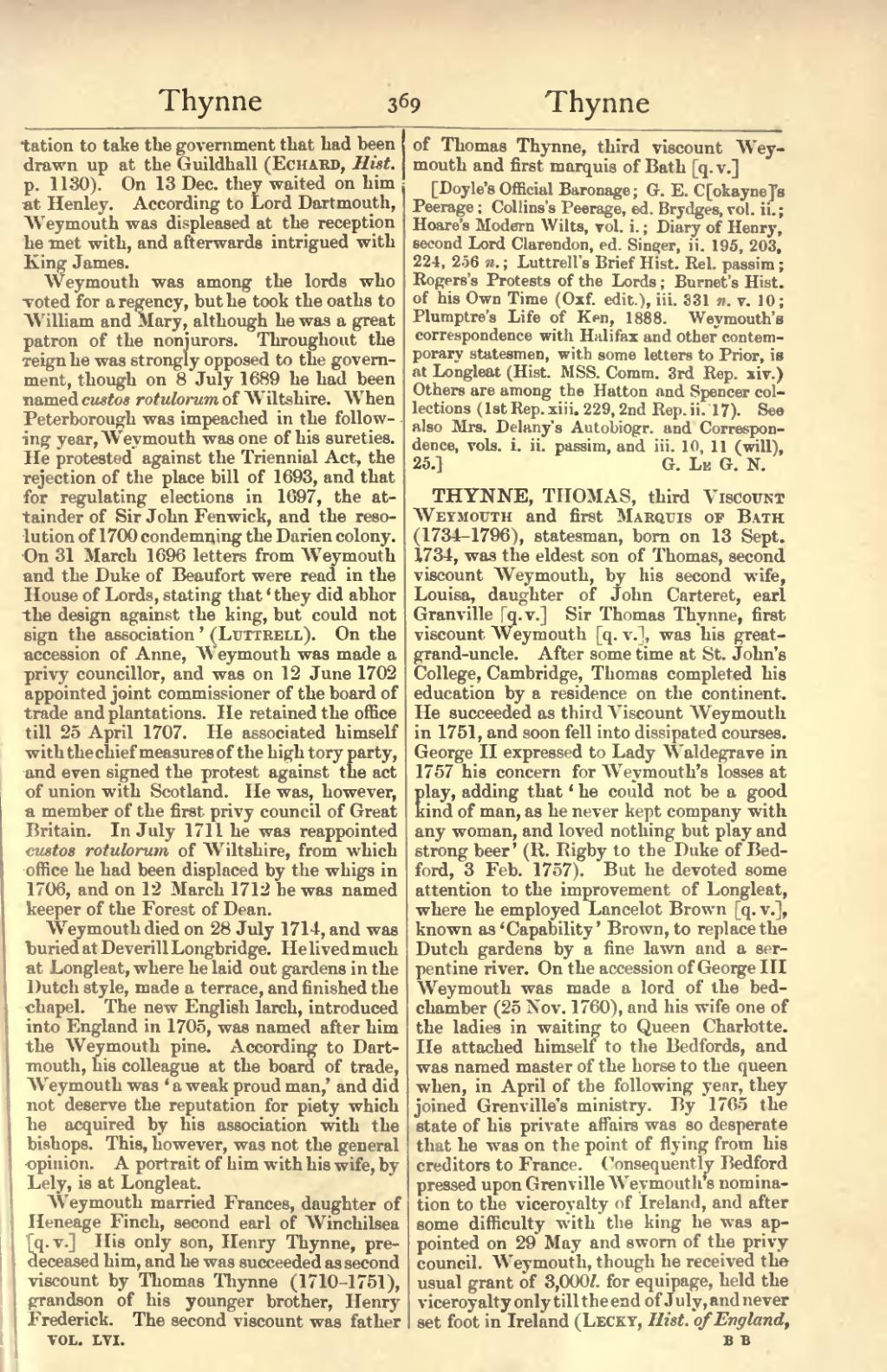tation to take the government that had been drawn up at the Guildhall (Echard, Hist. p. 1130). On 13 Dec. they waited on him at Henley. According to Lord Dartmouth, Weymouth was displeased at the reception he met with, and afterwards intrigued with King James.
Weymouth was among the lords who voted for a regency, but he took the oaths to William and Mary, although he was a great patron of the nonjurors. Throughout the reign he was strongly opposed to the government, though on 8 July 1689 he had been named custos rotulorum of Wiltshire. When Peterborough was impeached in the following year, Weymouth was one of his sureties. He protested against the Triennial Act, the rejection of the place bill of 1693, and that for regulating elections in 1697, the attainder of Sir John Fenwick, and the resolution of 1700 condemning the Darien colony. On 31 March 1696 letters from Weymouth and the Duke of Beaufort were read in the House of Lords, stating that 'they did abhor the design against the king, but could not sign the association' (Luttrell). On the accession of Anne, Weymouth was made a privy councillor, and was on 12 June 1702 appointed joint commissioner of the board of trade and plantations. He retained the office till 25 April 1707. He associated himself with the chief measures of the high tory party, and even signed the protest against the act of union with Scotland. He was, however, a member of the first privy council of Great Britain. In July 1711 he was reappointed custos rotulorum of Wiltshire, from which office he had been displaced by the whigs in 1706, and on 12 March 1712 he was named keeper of the Forest of Dean.
Weymouth died on 28 July 1714, and was buried at Deverill Longbridge. He lived much at Longleat, where he laid out gardens in the Dutch style, made a terrace, and finished the chapel. The new English larch, introduced into England in 1705, was named after him the Weymouth pine. According to Dartmouth, his colleague at the board of trade, Weymouth was 'a weak proud man,' and did not deserve the reputation for piety which he acquired by his association with the bishops. This, however, was not the general opinion. A portrait of him with his wife, by Lely, is at Longleat.
Weymouth married Frances, daughter of Heneage Finch, second earl of Winchilsea [q.v.] His only son, Henry Thynne, predeceased him, and he was succeeded as second viscount by Thomas Thynne (1710-1751), grandson of his younger brother, Henry Frederick. The second viscount was father of Thomas Thynne, third viscount Weymouth and first marquis of Bath [q. v.]
[Doyle's Official Baronage; G. E. C[okayne]'s Peerage; Collins's Peerage, ed. Brydges, vol. ii.; Hoare's Modern Wilts, vol. i.; Diary of Henry, second Lord Clarendon, ed. Singer, ii. 195, 203, 224, 256 n.; Luttrell's Brief Hist. Rel. passim; Rogers's Protests of the Lords; Burnet's Hist. of his Own Time (Oxf. edit.), iii. 331 n. v. 10; Plumptre's Life of Ken, 1888. Weymouth's correspondence with Halifax and other contemporary statesmen, with some letters to Prior, is at Longleat (Hist. MSS. Comm. 3rd Rep. xiv.) Others are among the Hatton and Spencer collections (1st Rep. xiii. 229, 2nd Rep. ii. 17). See also Mrs. Delany's Autobiogr. and Correspondence, vols. i. ii. passim, and iii. 10, 11 (will), 25.]
THYNNE, THOMAS, third Viscount Weymouth and first Marquis of Bath (1734–1796), statesman, born on 13 Sept. 1734, was the eldest son of Thomas, second viscount Weymouth, by his second wife, Louisa, daughter of John Carteret, earl Granville [q. v.] Sir Thomas Thynne, first viscount Weymouth [q. v.], was his great-grand-uncle. After some time at St. John's College, Cambridge, Thomas completed his education by a residence on the continent. He succeeded as thiid Viscount Weymouth in 1751, and soon fell into dissipated courses. George II expressed to Lady Waldegrave in 1757 his concern for Weymouth's losses at play, adding that 'he could not be a good kind of man, as he never kept company with any woman, and loved nothing but play and strong beer' (R. Rigby to the Duke of Bedford, 3 Feb. 1757). But he devoted some attention to the improvement of Longleat, where he employed Lancelot Brown [q. v.], known as 'Capability' Brown, to replace the Dutch gardens by a fine lawn and a serpentine river. On the accession of George III Weymouth was made a lord of the bedchamber (25 Nov. 1760), and his wife one of the ladies in waiting to Queen Charlotte. He attached himself to the Bedfords, and was named master of the horse to the queen when, in April of the following year, they joined Grenville's ministry. By 1765 the state of his private affairs was so desperate that he was on the point of flying from his creditors to France. Consequently Bedford pressed upon Grenville Weymouth's nomination to the viceroyalty of Ireland, and after some difficulty with the king he was appointed on 29 May and sworn of the privy council. Weymouth, though he received the usual grant of 3,000l. for equipage, held the viceroyalty only till the end of July, and never set foot in Ireland (Lecky, Hist. of England,
